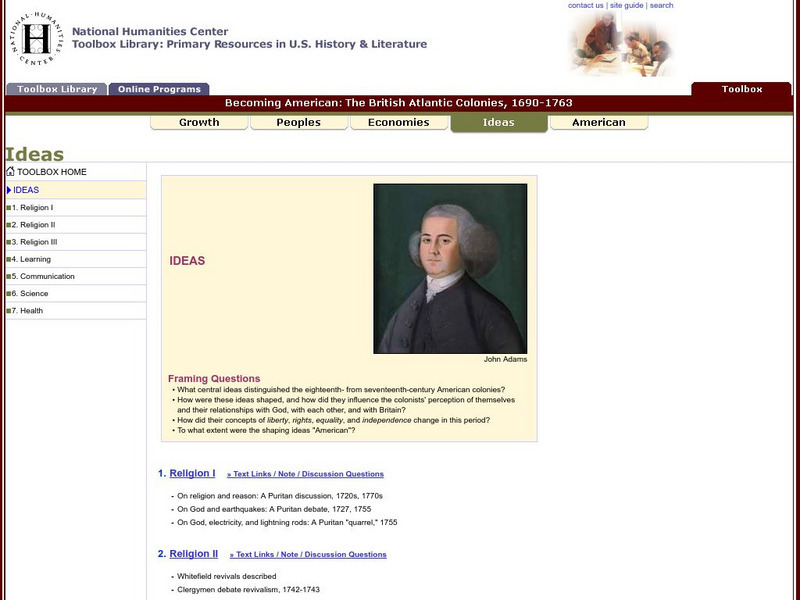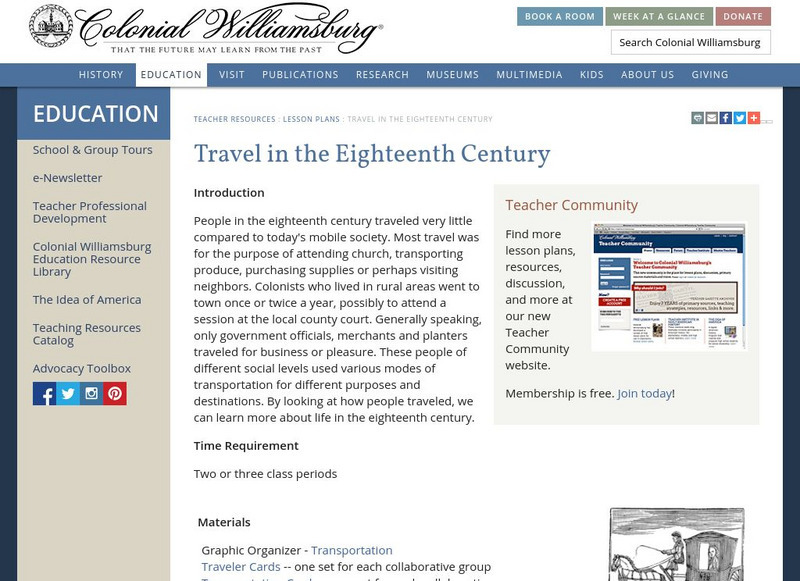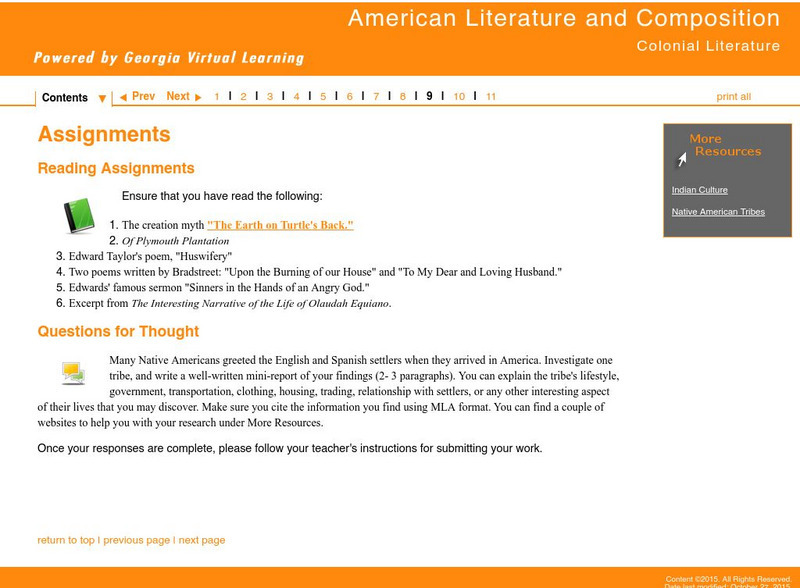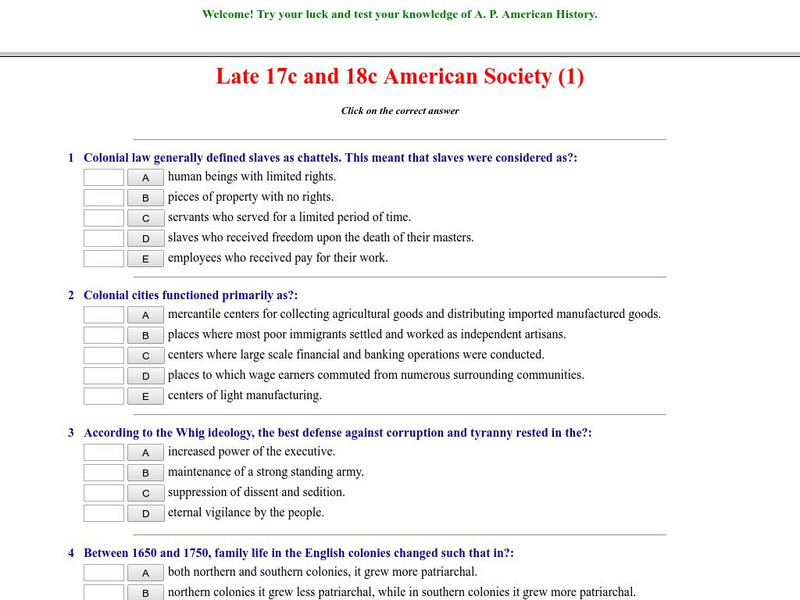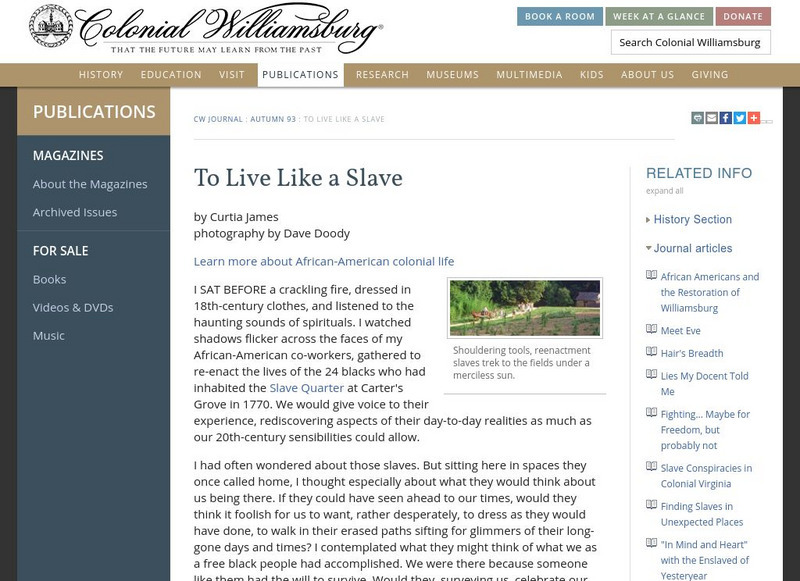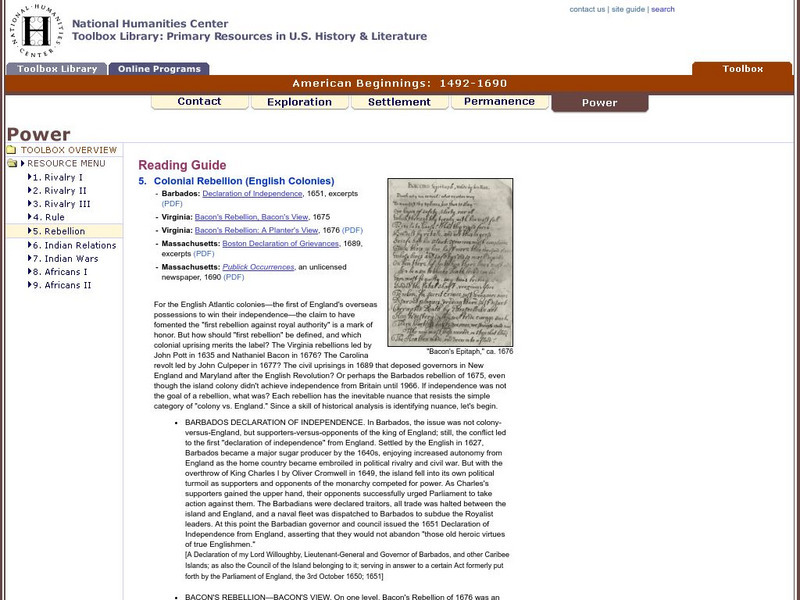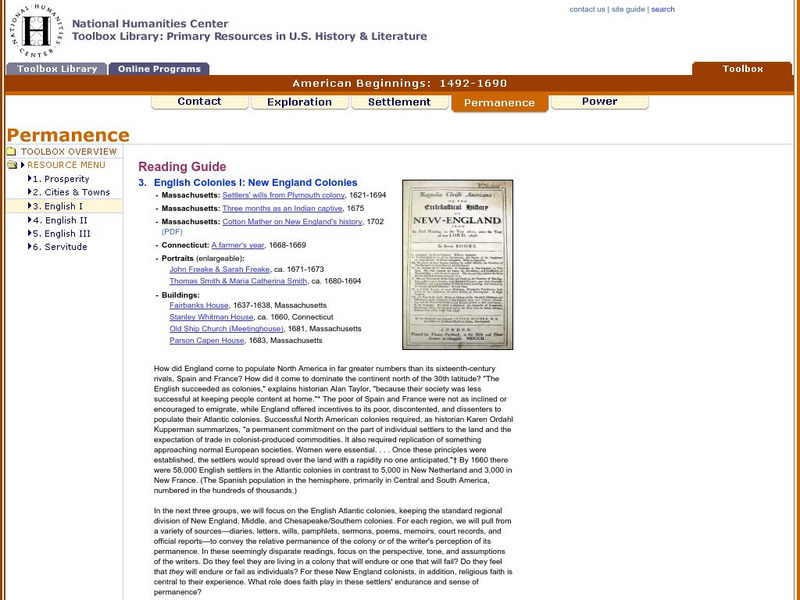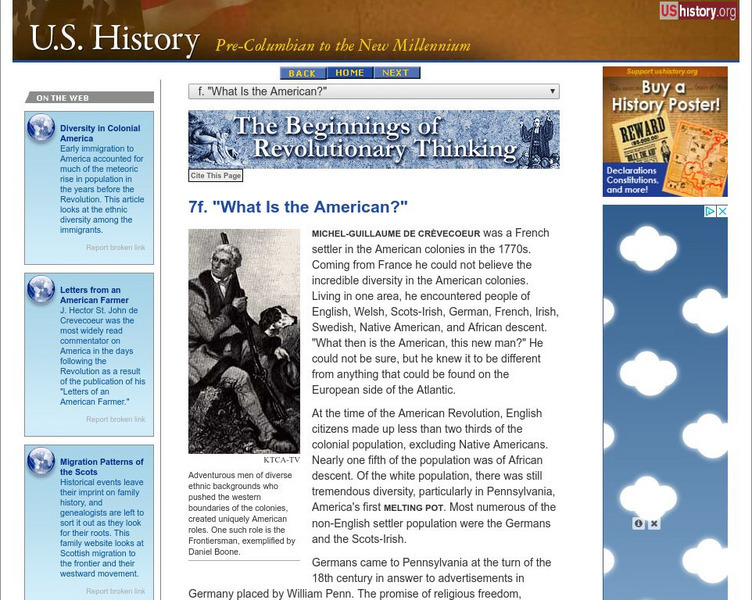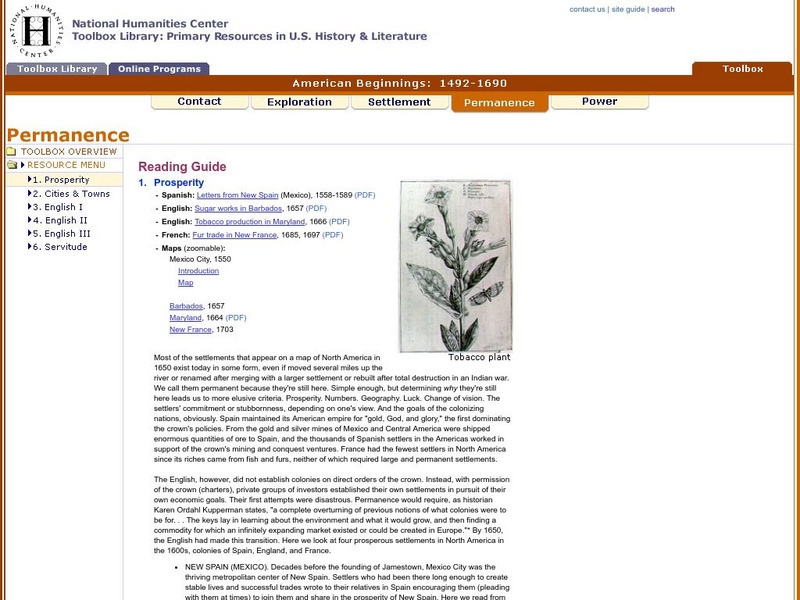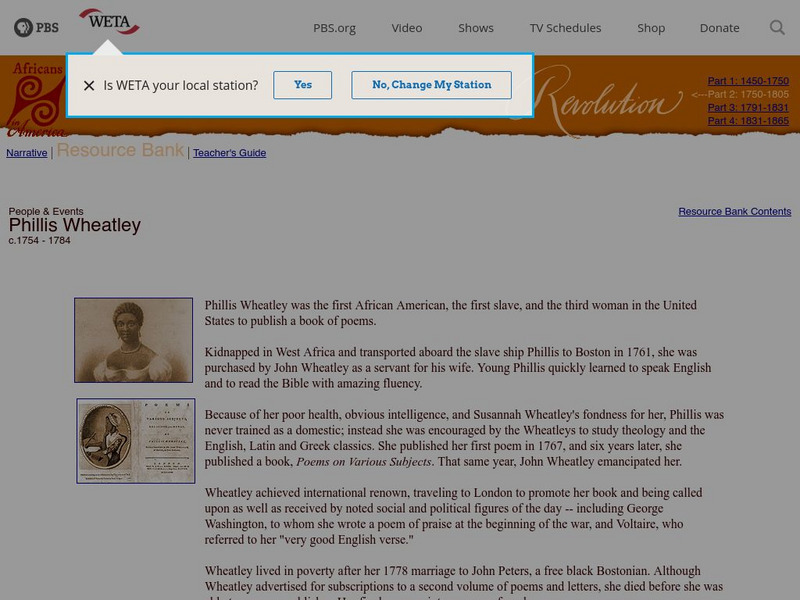National Humanities Center
National Humanities Center: Toolbox Library: Becoming American: The British Atlantic Colonies, 1690 1730
Primary resource material on the ideas, scientific and religious, of the colonial period from 1690 to 1730.
Colonial Williamsburg Foundation
Colonial Williamsburg: The Two Williamsburgs
This lesson plan on daily life in Colonial Williamsburg challenges learners to compare and contrast the lives of the African and European populations.
Colonial Williamsburg Foundation
Colonial Williamsburg: Travel in the 18th Century
This site has a lesson plan that contrasts the methods of travel during Colonial Times, with those of today.
Smithsonian Institution
National Museum of American History: Within These Walls
Two hundred years' worth of American history all in one house. Learn what a close examination of a single-family dwelling can tell us about what life was like during five different periods of American history: the colonial era, the...
Georgia Department of Education
Ga Virtual Learning: Colonial Literature Assignments
This lesson focuses on the assignments for the unit on Colonial Literature. It features a list of reading assignments, thought questions, a mini-research project assignment, and links to websites on Native American Culture and Native...
History Teacher
Historyteacher.net: Late 17 C and 18 C American Society: Quiz (1)
This 11-question multiple choice quiz is immediately scored and includes a variety of questions covering life in the early colonies.
Colonial Williamsburg Foundation
Colonial Williamsburg: Colonial Religion
The site provides a detailed overview of role religion played in the lives of the colonists. Content explores how religion played a part in the Revolution, and the statute for religious freedom, as well as providing a lesson plan, a link...
Henry J. Sage
Sage American History: The Puritans of New England
A description of religious strife and factions in the 17th Century. Provides a detailed and comprehensive account of the Puritans, their life and culture, as they migrate to America and establish themselves in New England.
University of Groningen
American History: Outlines: William Byrd (1674 1744)
A short essay about William Byrd from the colonial period of American history who detailed life in the Southern colonies.
Other
Organization of American States: Simon Bolivar
An informative exploration of the life of Simon Bolivar, the man known in South America as the "Liberator," because he led revolutions against Spanish colonial overlords in Venezuela, Ecuador, Peru, and Colombia.
EL Education
El Education: Native American Living Then and Now
After studying Native American life in colonial times and comparing it to both stereotypes and truths about modern-day life for Native Americans, students create a book providing illustrations and information about past and present culture.
Smithsonian Institution
National Museum of American History: You Be the Historian
Exercise involves learners in figuring out what life was like two hundred years ago for the colonial American Springer family by examining objects and documents they left behind.
Colonial Williamsburg Foundation
Colonial Williamsburg: To Live Like a Slave
A great article written by a modern African American woman who reenacted her ancestor's life of slavery. Pictures and great insight into the life of a slave.
National Humanities Center
National Humanities Center: Toolbox Library: Rebellion, American Beginnings: 1492 1690
Five documents that examine a range of reactions to colonial rebellion and associated resistance to royal authority in English colonies in Barbados, Virginia, and Massachusetts.
National Humanities Center
National Humanities Center: Toolbox Library: English I, American Beginnings: 1492 1690
Portraits of early New Englanders as well as four buildings from seventeenth-century New England that accompany accounts in those British colonies of struggles, Indian hostilities, and economic success.
Smithsonian Institution
National Museum of American History: Price of Freedom: Tricorn Hat
See a picture of the tricorn hat, worn by militiamen in the Revolutionary War. You can also read about the history of this particular hat.
Smithsonian Institution
Smithsonian American Art Museum: Young America in Art
An historical site from the Smithsonian American Art Museum that shows the growth of America through art work by over 45 artists. This site by the Smithsonian Institute has fascinating images showing American artists depicting the...
Independence Hall Association
U.s. History: Beginnings of Revolutionary Thinking: What Is the American?
Even colonial America was a melting pot of people from far away. Read about the diversity of the population and why it had an effect on the possibility of rebellion and revolution.
National Humanities Center
National Humanities Center: Toolbox Library: English Ii, American Beginnings: 1492 1690
Three seventeenth-century homes in Pennsylvania and New York and three accounts from those English colonies of the factors leading to prosperity and permanence.
National Humanities Center
National Humanities Center: Toolbox Library: Prosperity, American Beginnings: 1492 1690
Four original source accounts, and four related maps, of successful English, French, and Spanish settlements in North America and the Caribbean that explain the qualities of these settlements and their reasons for permanence and prosperity.
Books in the Classroom
Carol Hurst's Children's Literature Site: Colonial America
A detailed resource of recommended children's books on Colonial America, including discussion and research starters, teaching activities, and title suggestions.
PBS
Africans in America: Phillis Wheatley
This website briefly describes the life of Phillis Wheatley, poetess and freed slave.
Tom Richey
Tom richey.net: Native American Cultures 1491 1607 [Ppt]
Presents key ideas for examining the cultures of Native American tribes that lived in North America in early colonial times. Discusses the major groups, the way of life of each group, and where they lived.
Metropolitan Museum of Art
Metropolitan Museum of Art: Coffee, Tea, and Chocolate in Early Colonial America
Several examples of pots for coffee, tea, and chocolate from the colonial period. Learn how Americans adopted the practice of drinking coffee and tea, and how this practice affected society, daily life, and the decorative art created by...


